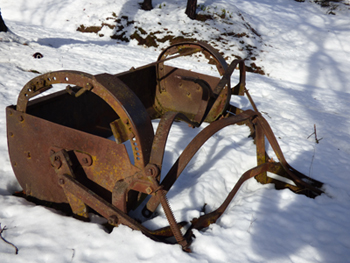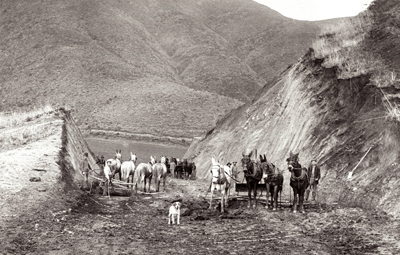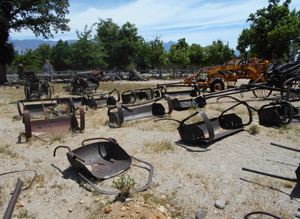
Questions?
Email us at: JandK@LivingGoldPress.com
 HOME
HOME
 |
Email us at: JandK@LivingGoldPress.com
|
Fresno Scrapers, Treasure NOT Trash!© Jill Livingston 2017 A version of this article originally appeared in Jefferson Backroads February 2017 |

|
 Building a California highway with mules and Fresno scrapers (CSU Library Special Collections) |
 A collection of scrapers at the Eastern California Museum in Independence, CA |
|
As it happened, the device in the photo was found and thankfully rescued from a scrap metal yard; to this writer at least, it is indeed a treasure. And believe it or not the gadget, called a Fresno Scraper, was a very innovative piece of equipment in its day! The tool looks primitive to the modern eye, yet “Fresnos” as they were often called, revolutionized the tasks of leveling fields, digging irrigation ditches, and building roads, tasks that would have been even more backbreaking without them. If you were a shovel man around the turn of the 20th century, you appreciated this. As a piece of earth-moving equipment, the Fresno Scraper is in essence a small horse or mule-drawn bulldozer. Earlier scrapers that were little more than glorified boards set up on edge, leveled the ground by pushing dirt along in front of said boards. The soil then had to be moved to the side or spread in a low spot using shovels and wheelbarrows. But this new device featured a rotating blade that directed the load where you wanted it to go and had a one-yard capacity. The two horse model sold for $28. John Porteous, the inventor, was a Scottish immigrant. Living in California, he listened attentively to farmers complaining about their difficulties leveling fields and digging irrigation ditches. Then he started tinkering. He patented his first Scraper in 1883, then opened the Fresno Agricultural Works to manufacture and sell the ground-breaking (literally!) tools. And sell them he did. Thousands were sent off around the country and across the world. There followed new improved versions and then various knockoffs, leading to “fresno” (with a small “F”) becoming a generic name. They were used in agriculture, highway and railroad grading, canal building (especially the Panama Canal) and general construction, and were used by the army in World War I. A 1912 contract for building a portion of the Pacific Highway (later to be US99) lists wages for a “two horse fresno and driver” at $5 a day, $6.50 a day for a “four horse fresno and driver”. A laborer (that man with a shovel) received $2 a day. By the 1930s tractors were used to pull larger capacity scrapers and soon self-propelled scrapers appeared. The humble fresnos were abandoned to rust but have been acknowledged by engineers to be one of our most significant “modern” inventions. They helped shape the land starting in California's Central Valley and eventually all around the world. They can be found here and there abandoned and forgotten, or conversely, treasured and used as decorative yard ornaments. |